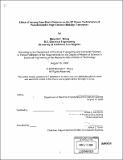Effect of varying gate-drain distance on the RF power performance of pseudomorphic high electron mobility transistors
Author(s)
Wong, Melinda F
DownloadFull printable version (24.52Mb)
Other Contributors
Massachusetts Institute of Technology. Dept. of Electrical Engineering and Computer Science.
Advisor
Jesús A. del Alamo.
Terms of use
Metadata
Show full item recordAbstract
AIGaAs/lnGaAs Pseudomorphic High Electron Mobility Transistors (PHEMTs) are widely used in satellite communications, military and commercial radar, cellular telephones, and other RF power applications. One key figure of merit in these applications is RF power output. Increasing the gate-to-drain length (LRD) of the PHEMT leads to an increase in its breakdown voltage. This should theoretically allow the selection of a higher drain operating voltage and consequently result in higher output power at microwave frequencies. However, experimentally, a decrease in output power and peak power-added efficiency is generally observed with increasing LRD In order to understand this, we have studied in detail the RF power performance of industrial PHEMTs with different values of LRD. We have found that there is an optimum value of LRD beyond which the maximum RF power output that the device can deliver drops. In addition, we have found that the output power of long LRD devices declines significantly with increasing frequency. We explain the difference in RF power behavior of the different devices through the evolution of load lines with frequency, LRD, and operating voltage. We have found that the presence of oscillations in the NDR region limit the maximum allowable operating voltage of long LRD devices through catastrophic burnout. The maximum voltage of short LRD devices is limited by electrical degradation. Pulsed I-V measurements have revealed that long LRD devices increasingly suffer from surface state activity that limit the maximum drain current under RF operation. A delay time analysis has shown an increasing extension of the depletion region toward the drain with increasing LRD that limits the frequency response of long LRD devices.
Description
Thesis (S.M.)--Massachusetts Institute of Technology, Dept. of Electrical Engineering and Computer Science, 2005. Includes bibliographical references (p. 134-137).
Date issued
2005Department
Massachusetts Institute of Technology. Department of Electrical Engineering and Computer SciencePublisher
Massachusetts Institute of Technology
Keywords
Electrical Engineering and Computer Science.